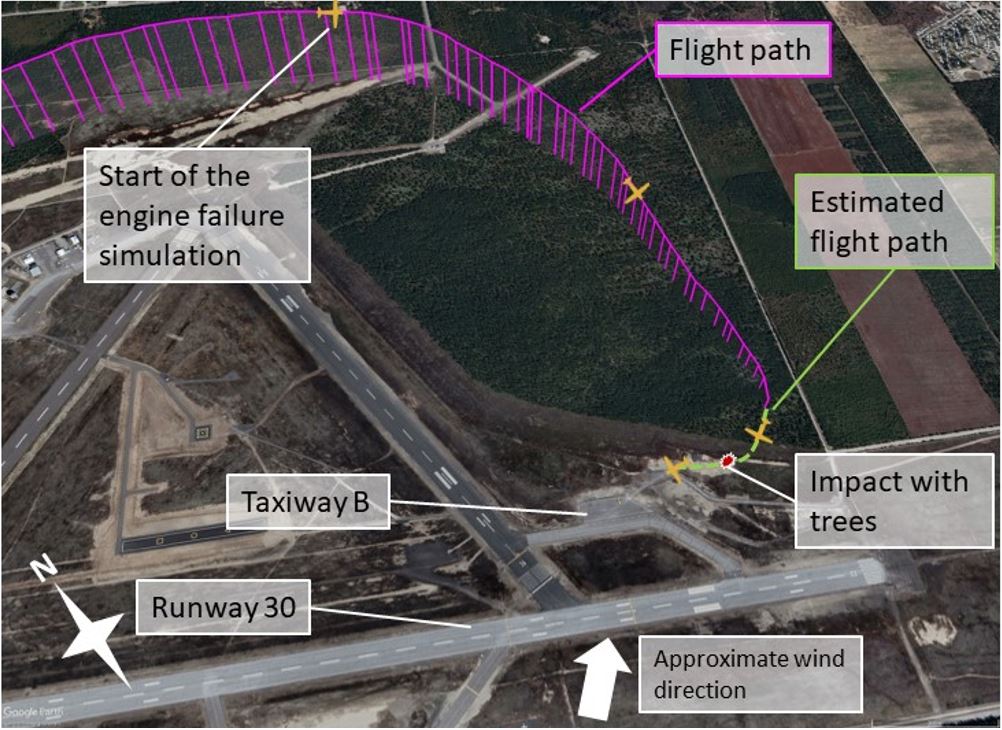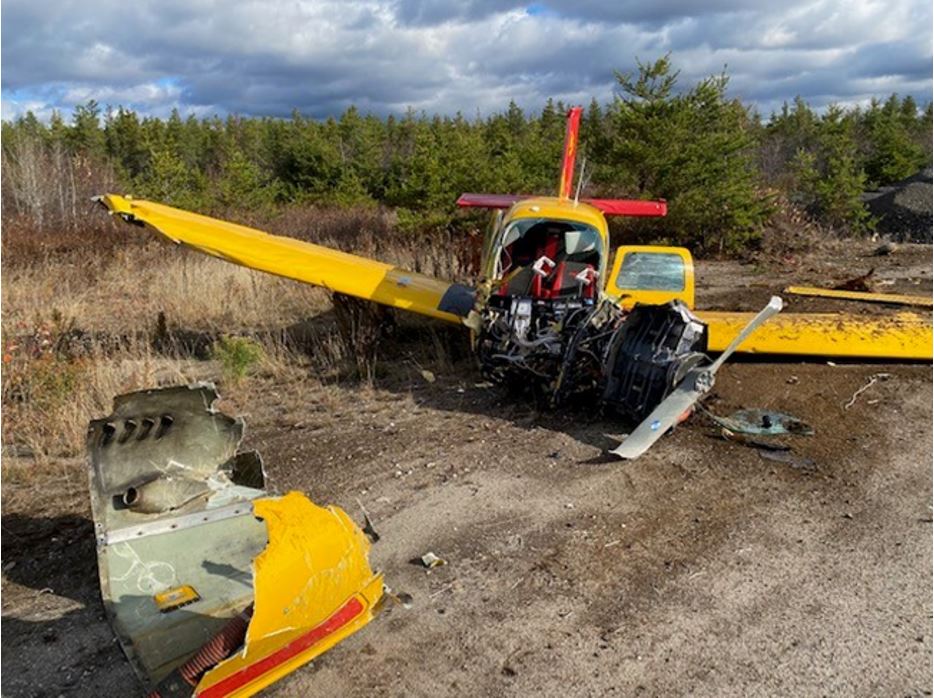Collision with terrain
Collège d’enseignement général et professionnel de Chicoutimi
Beech Aircraft Corporation C23 Sundowner, C-GBQI
Chicoutimi/St-Honoré Airport, Quebec
The Transportation Safety Board of Canada (TSB) investigated this occurrence for the purpose of advancing transportation safety. It is not the function of the Board to assign fault or determine civil or criminal liability. This report is not created for use in the context of legal, disciplinary or other proceedings. See Ownership and use of content. Masculine pronouns and position titles may be used to signify all genders to comply with the Canadian Transportation Accident Investigation and Safety Board Act (S.C. 1989, c. 3).
History of the flight
At 0840Footnote 1 on 21 October 2022, the chief flight instructor (CFI) for the Collège d’enseignement général et professionnel (CEGEP) de ChicoutimiFootnote 2 at the Chicoutimi/St-Honoré Airport (CYRC), Quebec, was tasked with conducting an evaluation flight following a student pilot’s first solo flight. The goal of the flight was to evaluate the student pilot’s progress and ability to conduct takeoffs, initial climbs, circuits, approaches, landings, go-arounds, and emergency procedures.
The student pilot conducted a pre-flight inspection of the Beech Aircraft Corporation C23 Sundowner aircraft (registration C-GBQI, serial number M-2264) and noted that the aircraft had 15 U.S. gallons of fuel in each tank (30 U.S. gallons total). Following the pre-flight inspection, the student informed the CFI that the aircraft may need additional fuel. The CFI replied that the fuel on board was sufficient for the intended flight without explaining why to the student pilot. The CFI and student pilot then boarded the aircraft.
After the start-up and pre-flight checks were completed, the student pilot called the tower controller to request a clearance to taxi and take off from Runway 30; however, the tower controller instructed the student pilot to hold short of Runway 30 on Taxiway A, as there was a delay because many aircraft were in the circuit. At 0940, the tower controller instructed the student pilot to backtrack on Runway 30 from Taxiway A. The aircraft backtracked just short of Taxiway D and turned around. The tower controller then cleared the aircraft to take off from that position (Figure 1).
At 0942, the aircraft took off from Runway 30 and started flying left-hand circuits at 1000 feet above ground level (AGL). After a few normal circuits, the CFI initiated a simulated engine failure while the aircraft was on the left downwind leg for Runway 30. The student pilot delayed the turn towards the runway, but successfully reached the runway, partly because of a tailwind that was present when the aircraft was on the base turn. The student pilot then conducted a touch-and-go and began another left-hand circuit. The CFI and student pilot discussed the simulated engine failure and the advantages of turning toward the runway immediately upon recognition of an engine failure in the circuit. Another left-hand circuit with a simulated engine failure was conducted, followed by another touch-and-go on Runway 30.
At 1019, the CFI called the tower controller to request a right-hand circuit at 500 feet AGL, which was approved. The student pilot had no previous experience conducting right-hand circuits from Runway 30, or circuits at 500 feet AGL. The goal of the right-hand circuit was to demonstrate the difference between a tailwind and a headwind on a simulated engine failure while on the base turn.
While the aircraft was on the right downwind leg for Runway 30 at approximately 500 feet AGL, the CFI initiated a simulated engine failure and informed the tower controller of the exercise. The student pilot turned the aircraft toward the Runway 30 threshold but determined that they would not be able to reach the runway. The student pilot suggested aiming for a nearby field. After a quick discussion between the CFI and the student pilot, it was decided to aim for Taxiway B.
As the aircraft was heading towards Taxiway B, it became evident to the student pilot and the instructor that they were not going to reach the intended landing point. The aiming point was then altered to a cleared gravel area short of Taxiway B. At approximately 1022, the aircraft's right wing contacted small trees and the aircraft collided with terrain in the cleared gravel area (Figure 2). At no point during this simulated-engine-failure exercise was an overshoot initiated by either the student pilot or the CFI.
The CFI and student pilot were both wearing the available 3-point safety harnesses. Once the aircraft came to a stop, they were able to egress through the aircraft doors. Both received minor injuries.
The aircraft was destroyed. The emergency locator transmitter activated. There was no fire.
Pilot information
Chief flight instructor
The CFI was hired by CEGEP de Chicoutimi in 2009 and became the flight training unit’s CFI in 2015. At the time of the occurrence, he had accumulated approximately 7000 hours total flight time, of which approximately 2500 hours were instructional hours. He held an airline transport pilot licence – aeroplane and a Class 2 flight instructor rating. The CFI was the pilot-in-commandFootnote 3 of the flight.
Student pilot
The student pilot held a student pilot permit and had begun flight training in August 2022. At the time of the occurrence, the student pilot had accumulated approximately 15 hours total flight time.
Weather information
The nearest weather reporting station to CYRC is Bagotville Airport (CYBG), Quebec, located 11 nautical miles to the south-southeast. At 1000, the weather was reported to be:
- Winds from 230° true at 7 knots
- Visibility of 25 statute miles
- Few clouds at 4000 feet AGL
- Temperature 8 °C and dewpoint 0 °C
Aircraft information
The Beech Aircraft CorporationFootnote 4 C23 Sundowner is a 4-seat, low-wing, tricycle-gear aircraft equipped with a single 4-cylinder piston engine. The occurrence aircraft was built in 1980 and had accumulated 8279.6 hours since new. The aircraft has a fuel capacity of 59.8 U.S. gallons (29.9 U.S. gallons in each wing fuel tank).Footnote 5 The aircraft’s pilot operating handbook prohibits a takeoff “when Fuel Quantity Gages [sic] indicate in Yellow Band on either gage [sic].”Footnote 6 The yellow band of the fuel gauges corresponds to a tank fuel level between empty to 1/3 full,Footnote 7 which is approximately 10 U.S. gallons per tank. Therefore, taking into consideration the planned flight time of the evaluation flight, the fuel on board the aircraft (30 U.S. gallons) was sufficient for the intended flight.
The investigation did not uncover any defects with the aircraft before the collision with the terrain.
Wreckage examination
The aircraft came to a rest in a gravel area to the east of Taxiway B. It sustained substantial damage to its nose, wings, and gear (Figure 3). The cockpit survivable space remained intact, and the cockpit doors were useable.
The trees that the aircraft contacted were approximately 20 feet tall and had previously lost their leaves, which made them difficult to see because there was little contrast with the surrounding gravel area (Figure 4).
Flight training unit
The CEGEP de Chicoutimi is a Transport Canada approved flight training unit. It is authorized to conduct training for private and commercial pilot licences, as well as for numerous pilot ratings.
The flight training unit normally assigns 1 instructor to each student for private pilot licence training. Then, as part of the structured flight training syllabus, a different instructor will conduct certain evaluation flights, such as the evaluation after the student pilot’s first solo flight. The objective of this evaluation flight is to determine if the pilot is capable of further solo flights. The student pilot is graded on the flight.
Minimum altitude guidance
Transport Canada’s Flight Training Manual – Aeroplane provides “basic, progressive study material for student pilots preparing for licensing, pilots improving their qualifications, and for the guidance of flight instructors.”Footnote 8
The Flight Training Manual – Aeroplane states that for simulated engine failure exercises,
[w]ith the exception of those approaches made to an aerodrome, all simulated forced landings should be practised in the local practice area, and only to the minimum altitude specified by the Canadian Aviation Regulations or the training unit when they are more restrictive.Footnote 9
The Canadian Aviation Regulations require aircraft to remain at least “500 feet from any person, vessel, vehicle or structure” Footnote 10 except when taking off and landing, or “where the aircraft is operated without creating a hazard to persons or property on the surface and the aircraft is operated for the purpose of […] flight training conducted by or under the supervision of a qualified flight instructor.”Footnote 11
At the time of the occurrence, the flight training unit did not have a policy that established a minimum overshoot altitude for simulated engine failures leading to an off-runway landing, and did not have standard phraseology for an overshoot call.
TSB laboratory reports
The TSB completed the following laboratory report in support of this investigation:
- LP103/2022 – NVM Recovery – MFD
Safety action taken
After this occurrence, the CEGEP de Chicoutimi introduced the following:
- a policy that sets a minimum altitude of 200 feet AGL for simulated engine failure exercises, unless the approach and landing is to a runway;
- a standard overshoot call; and
- a ban on conducting circuits at 500 feet AGL.
Safety messages
Operating aircraft at low altitudes, as is done during a simulated engine failure to a landing exercise, increases the risk of collision with obstacles and/or terrain. The pilot-in-command must consider the operating environment and ensure that adequate safety margins are maintained to allow sufficient reaction time to avoid obstacles or to respond to an aircraft malfunction.
This report concludes the Transportation Safety Board of Canada’s investigation into this occurrence. The Board authorized the release of this report on . It was officially released on .
![Approximate position of the start of the take-off roll (Source: NAV CANADA, Canada Flight Supplement [CFS], with TSB annotations)](/sites/default/files/eng/rapports-reports/aviation/2022/a22q0126/images/a22q0126-figure-01.jpg)


